by Herb Adler 5243 3409
January 2021: Herb has revisited this here.
A problem I had with the BB, since I actually got it running, was dieseling, or running on, when the ignition was turned off. It could be so bad that the engine seemed about ready to leap out of the car, all of which made me scared to actually turn the engine off.
THE SOLUTION?
Some time ago I read , on Paul Hunt's webpage (www.mgb-stuff.org.uk), on methods of stopping this. All I remembered was to fit an awfully big valve to dump lots of air into the inlet manifold or to apply a vacuum to the overflow ports on the carbys, to suck fuel out of the jets. Actually I couldn't even remember where I had gotten these ideas from, I only found out after I had developed my own system.
Anyway, after a lot of thinking (procrastinating?), I bit the bullet and trotted off to my favourite wrecker, to see if I
could find a solenoid valve, as used in anti pollution plumbing. Well I was lucky and did find one, two actually, on the one bracket as a single assembly. They didn't look the best, the surfaces where oxidised to a dull grey, but what the --, they only cost me $10.
When I got home I immediately tested them, and yes, they both worked, closed with no power and open with power applied.
Well now to see if my idea works, so off to the car and with tape and cable ties cobble together a system, using an old ¼” BSP hose tail to fit into the manifold an extra T piece in the overflow/vent tubing and a change over relay, connected so that when the ignition is turned off the ignition warning light terminal from the alternator is connected to the solenoid valve. This worked fairly well, with only an occasional cough, when turning off. At this point I was concerned that the 2mm bore of the valve would be struggling to compete with the 6mm of tubing open to atmosphere at the other end, so I inserted a restrictor in the line, (a piece of ABS tubing, with a 2mm hole). At this point I decided that the system was eminently suited and decided to install it permanently.
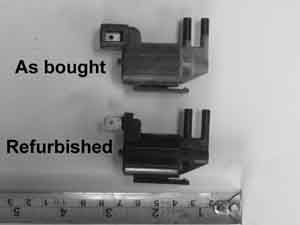 So, first thing is to refurbish one of the valves, using shoe polish.
So, first thing is to refurbish one of the valves, using shoe polish.
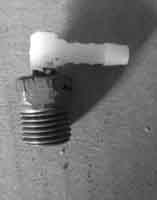 Then to make a proper fitting to tap into the manifold, which I did by cutting the barb off that hose tail, drilling out to 6mm and pressing a 5mm elbow into it, with a bit of silicon rubber to ensure a good seal.
Then to make a proper fitting to tap into the manifold, which I did by cutting the barb off that hose tail, drilling out to 6mm and pressing a 5mm elbow into it, with a bit of silicon rubber to ensure a good seal.
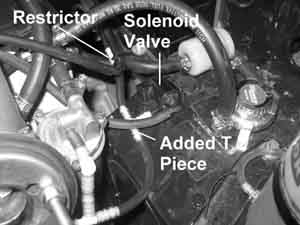
 Then mount the valve near the washer bottle insert a T piece into the overflow line and connect up hoses.
Then mount the valve near the washer bottle insert a T piece into the overflow line and connect up hoses.
After running with this setup, I found that it was a bit less than ideal, still getting run-on, but not as bad as previously. For whatever reason I decided that the vacuum, straight from the manifold, was not reliable enough, so I went scrounging for a vacuum canister, at the wrecker's.
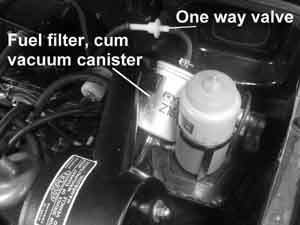
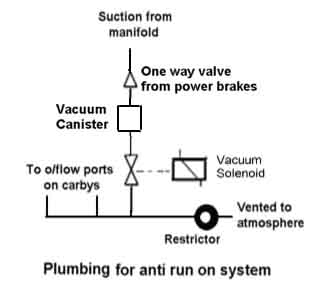 I couldn't find an actual vacuum canister, but I did find a large metal fuel filter. I thinks “that will do till I can get a proper one”. I also scrounged a one way valve, from the vacuum line to a power brake booster.
I couldn't find an actual vacuum canister, but I did find a large metal fuel filter. I thinks “that will do till I can get a proper one”. I also scrounged a one way valve, from the vacuum line to a power brake booster.
Well, this idea didn't seem to make any difference, until I had a brain wave (just about burnt out the last of my grey cells). That fuel filter cum vacuum canister is full of petrol vapour, could this be sucked into the manifold directly and provide enough to ignite and cause the run-on? So wash out this filter with detergent and hot water, blow some air through it and re-install, though very temporarily.
This seems to have solved the problem, and the engine now stops, without any athletics under the bonnet.
ELECTRICS
I had a bit of difficulty trying to work out how to operate this solenoid, when power is turned off, and to ensure that it does not stay on once the engine has stopped. I thought about fancy electronic timers, but they draw power too.
Measuring the characteristics of the solenoid I found that at 12V it draws 400 mA of electric current, and stays actuated till the applied voltage drops to about 2.5V. My first thought was to connect it to the output of the alternator, via a relay's normally closed contacts. This relay is de-energized when the ignition is turned off, thus closing the contacts. As the engine is still spinning the alternator is still generating power, which will operate the solenoid, virtually until the engine stops. A brilliant idea, EXCEPT… the alternator output is permanently connected to the battery. Damn, this means that the solenoid would be energized all the time the ignition is off. Not good for retaining a charge in the battery. (This would work with a dynamo, as it is disconnected from the battery, with the ignition off, otherwise it would try to act as a motor). Out to the garage, up with the bonnet and stare at the works, hoping for inspiration to strike. It did! There are two wires from the alternator, one is the main power line to the battery and the other is to the ignition warning light. Ah ha, would there be any way this second wire could be used? Checking the alternator's circuit in the manual, I found that the ignition warning light is connected to the field winding, which has its own set of diodes, thus isolating it from the battery. I then agonised over whether these diodes could take an extra 1/2A or so without stress. After checking drawings of the alternator diode pack I decided that these diodes were quite hefty enough, and they also provided protection from voltage spikes that could be created by the solenoid turning off. So my dilemma of how to de-energize the solenoid when the engine has stopped was solved.
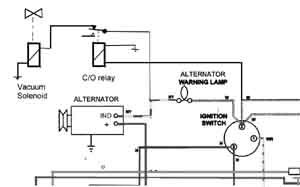 The final electrical connections.
The final electrical connections.
An alternative way that has been suggested, by Paul Hunt, is to connect the solenoid, via the normally closed contacts, of the relay, directly to the battery and have the earth connection via an oil pressure switch, that is CLOSED when there is pressure. When the engine stops the oil pressure bleeds away and the pressure switch opens, turning the solenoid off. A note here, this switch works in the opposite way to a normal pressure switch, which closes the contacts when there is no pressure (to turn on the oil pressure warning light).
